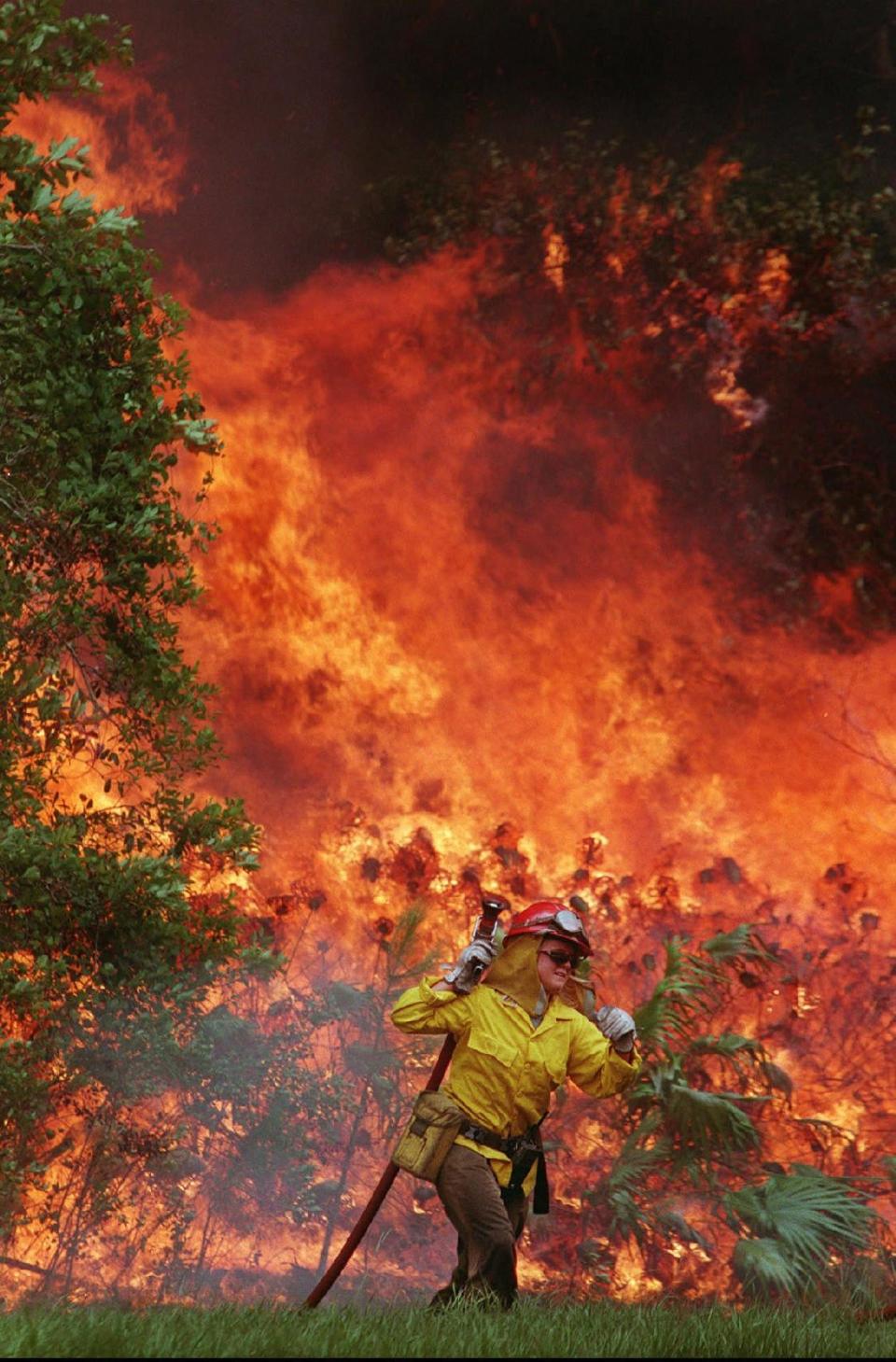Fallout from 1998 wildfires at Kennedy Space Center includes 'forever' chemicals
The fierce wildfires in 1998 had another unforeseen fallout at Kennedy Space Center, left undiscovered for two decades: a 69-acre plume of cancer-causing "forever" chemicals.
The chemicals are from the fire-fighting foam used to save NASA's South Repeater Building from the flames.
The building is a communications fiber-optic relay station and storage facility on Tel-4 Road, at the northeast corner of Audubon Road, southeast of North Courtenay Road, near KSC’s southern boundary.
The 1998 fires hit KSC hard, threatening several structures. More than 300 homes were destroyed statewide, 32 on the Space Coast during the "Summer of Fire."
But in saving the South Repeater Building and a nearby neighborhood, firefighters unleased untold volumes of a foam now known to cause cancer and other health and environmental threats over the long term.

Recently, KSC sent 37 property owners near the building notification of NASA's investigation into the chemical plume. The space agency also sent forms asking for permission to enter properties to conduct groundwater sampling. The sampling, which includes private wells, is at no cost to owners, KSC environmental officials said.
Here's what's happening:
What are the chemicals of concern?
A group of compounds called PFAS, also known as fluorinated or "forever chemicals" because they don't readily break down into harmless compounds.
Where does PFAS come from?
In addition to being in foams used to fight fires at rocket launch centers, airports and military bases, PFAS was formerly used in Teflon coatings and other products made to resist heat, oil and stains. It's use has been voluntarily phased out in nonstick cookware and many other consumer products.
Why is PFAS bad?
Recent human and animal studies suggest that PFAS exposure reduces antibody responses to vaccines, as well as infectious disease resistance in general. Emerging science is finding links between the compounds and several types of cancers and other illnesses, if ingested or breathed in over many years. They are fraught with so many unknows, however, that even the U.S. Environmental Protection Agency is struggling to figure out how to deal with them.
Where at KSC has PFAS been found?
There are a few dozen known sites totaling more than 530 acres of presumed PFAS plumes at KSC, according to a FLORIDA TODAY analysis of Geographic Information System data obtained from NASA under the Freedom of Information Act.
The compounds also have shown up in blood and tissues of alligators, manatees, dolphins and other wildlife at and near KSC for years. A paper from 2017 published in the journal Environmental Toxicology and Chemistry documented that the blood of alligators caught between 2012 and 2015 at the space center had the highest levels of toxic fluorinated chemicals ever measured in the species.
More: How a tragic 1981 fire at Kennedy Space Center changed the way feds fight fires
Here's how NASA answered FLORIDA TODAY'S questions about the South Repeater building:
If an owner gives right-of-entry, and NASA finds a problem, will NASA cover the cost of cleaning it up?
NASA’s priority is to protect human health and the environment. NASA is committed to the cleanup of PFAS affected groundwater originating from Kennedy, with Florida Department of Environmental Protection oversight.
NASA wants to determine whether affected groundwater has moved beyond our property. We also want to understand if individuals are on the City of Cocoa public water service and, if they have private wells, how they are using them.
We have tentatively identified locations that will help us determine if PFAS affected groundwater has moved beyond KSC’s property boundary.
What do recent sampling results show?
The area on Kennedy with confirmed PFAS affected groundwater is approximately 69 acres and extends from the South Repeater Building to the west towards State Road 3. NASA has sampled for up to 29 PFAS that were analyzed using EPA approved analytical methods.
Three specific PFAS (PFOS, PFOA, and PFHxS) have been detected in concentrations above EPA’s regional screening levels which are used to determine the need for additional investigation. NASA is initiating pilot studies for both restricting further movement as well as treating the PFAS affected groundwater.
Where can I find out more?
Contact Anne M. Chrest, KSC remediation program manager, via email at anne.m.chrest@nasa.gov, or visit https://public.ksc.nasa.gov/environmental/pfas/
This article originally appeared on Florida Today: The 1998 wildfires at Kennedy Space Center left 'forever' chemicals

